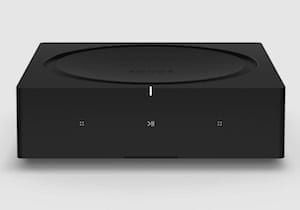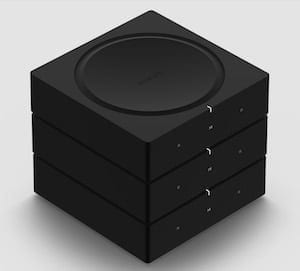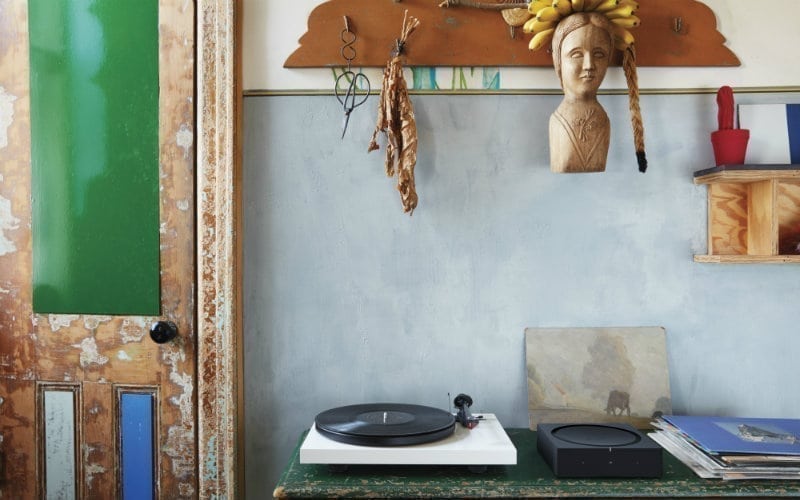Written by Jeremy Glowacki

Sonos, one of the best-known brands in home audio, is adding a new piece of hardware called the Sonos Amp that is designed to drive systems as simple as a turntable and a pair of speakers to something as powerful as an entire house of streaming music.
This new “home audio hub” can power traditional wired speakers with sound from nearly any source and fully integrates these speakers into Sonos’ wireless home sound system. It supports Apple’s AirPlay 2 and more than 100 streaming services and includes an HDMI Arc port for TVs.
Launching globally to consumers via the Sonos website in February 2019, the $599 Amp will be available first to professional installers in the United States and Canada starting December 1, 2018.
“The world is changing fast, and we need to be there for the installer community,” said Matthew Seigel, Sonos chief commercial officer, during a media preview at Sonos’ Boston offices on August 23. “It is more powerful and is designed in a way to stack perfectly inside an AV rack, to be placed inside a cupboard, or left out on a counter. It was built in collaboration with our partners after understanding what they needed over the past two years. There’s a ton of strategic alignment between the installer community and Sonos.”
A More Powerful Sonos Amp
Amp is twice as powerful as its predecessor, the Connect:Amp. A single Amp can power up to four speakers with 125 watts per channel. To power a multi-room audio system, as many as 32 Amps could be mounted inside a component rack.

HDMI and line-in ports on the back of an Amp means that TVs, turntables, CD changers, and other audio components can easily connect to the device and become part of the Sonos system.
Amp’s hardware was built to power the Sonos software platform. New updates to the platform make it easy for installers to incorporate Amp into integrated smart home set-ups, including smart lighting and centralized control systems. It is also AirPlay 2 compatible, meaning music and other audio from any iOS device can be played wirelessly through Amp. And when wirelessly connected to an Amazon Alexa-enabled device, like a Sonos One or Beam, Amp is controllable with voice commands.
“The growth of the sonic internet — the convergence of paid streaming, the smart home, and artificial intelligence through voice technologies — drives everything we do at Sonos,” said Sonos CEO Patrick Spence. “While plug-and-play options like Sonos Beam and Sonos One are an important part of the equation, architectural sound and making it even easier to integrate with lighting and home control are equally as important. We’ve listened to custom installers and dealers to create Amp, a versatile product designed to be at the center of the smart home sound experience.”
Expanding Into the Architectural Amp Space
As part of its Amp media event, Sonos also announced a collaboration with architectural audio manufacturer Sonance aimed at delivering a series of three architectural speakers — in-wall, in-ceiling, and outdoor — that gain additional functionality through software when paired with the new Sonos Amp. This collaboration will provide a complete offering for professionally installed architectural sound, exclusively enabling Sonos’ Trueplay tuning capabilities to ensure the best sound for the space as well as the benefits of Sonos’ software platform. These products, which will be sold and marketed by Sonos, will launch in early 2019.
The platform will continue to expand with new APIs that allow partners to innovate on their integrations with Sonos. New control APIs and features can make the experience better for customers, especially those with integrated control systems, such as Control4 and Crestron.
Features may include line-in switching (for both analog and home theater), to allow for components to be selected within the third-party control interface. Volume pass-through would allow for easier and more predictable volume control. And, the ability to add Sonos playlists will be enabled within a third-party interface. Eventually, other capabilities may include notifications and alerts from third- party devices, like a doorbell, through Sonos speakers.










